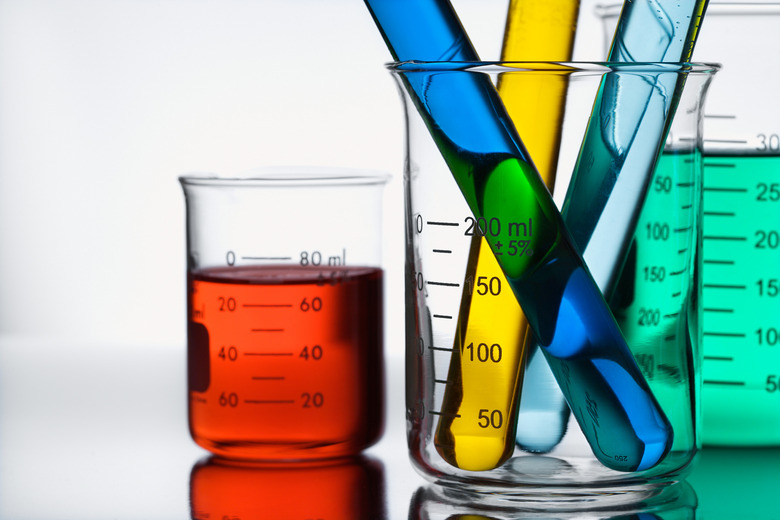Drawbacks Of Qualitative Evaluation In Chemistry Experiments
Qualitative evaluations in chemistry experiments partition reactions and substances into subjective categories, which is useful for quick and easy assessments of broad differences. However, the science of chemistry would be limited in its ability to provide accurate and precise information about chemical reactions if only qualitative evaluations were used. For example, light brown, medium brown, dark brown and darker brown are qualitative evaluations of a chemical product that might be useful to a chemist if that person knew from prior experience what each color meant regarding the reaction. However, without quantitative evaluation it would be difficult to calculate reaction rates and molar proportions, which is the backbone of methodologies that study chemical reactions. In addition, qualitative evaluations of chemical reactions are hard to reproduce, since something such as the degree of brown-ness is subjective, varying from person to person.
What Do You Mean?
What Do You Mean?
The study of chemistry involves balancing equations. Reactants are combined to form a reaction, which results in products. The Law of Conservation of Mass dictates that however much mass is found in the starting reactants must be accounted for in the amount of products. This allows chemists to calculate the exact mass of their product. Qualitative evaluations such as "a little bit of powder," "some powder" or "lots of powder" would still partition the results into different categories, but would not allow for exact calculations that determine how efficient a reaction was in producing a product.
I Didn’t Know That
I Didn't Know That
Qualitative evaluations of chemistry experiments produce knowledge that is less transferable to other people. For example, determining that a chemical reaction went to completion somewhat quickly is not helpful to another person who wants to repeat the experiment to get the same result. Categorizing reaction rates as slow, somewhat fast and rapid may be helpful to the experimenter who has performed the experiment before and remembers what each rate category means – it may save them time if they didn't have to numerically measure the reaction every time. However, it would be difficult for others to be sure that the same chemical reaction repeated as it should have, based on their subjective assessment of what fast means.
Something Missing
Something Missing
Chemical reactions form products with different properties. Some are solid, others liquid, and others gas. Products can be lost during the measurement process because they remain stuck to the inside of test tubes, or they may not completely react. This results in different amounts of products being formed depending on the type of reaction. Chemists often calculate percent yield, which is a measure of how efficient their recovery of a product is compared to what they should theoretically be getting, based on the balanced chemical equation of the reaction. Qualitative evaluations partition the amount of product of a chemical reaction into non-numerical categories that are not subject to mathematical manipulations such as subtraction and division, which is required to calculate percent yield.
Fast But Furious
Fast But Furious
Chemicals have different affinities for each other, meaning some react together faster than others to form products. Sometimes the desired product of a reaction, say a life-saving drug, doesn't readily form. Chemists have ways of speeding up the reaction or making it more efficient, in order to get more product. However, they need to calculate the rate of the reaction, which requires that they measure the exact amount of products formed within a certain amount of time. Qualitative evaluations give answers that are not only subjective, but too broad to be accurately fine-tuned. Even if the experimenter tried to fine-tune the reaction by changing the conditions of the reaction, qualitative evaluations such as "the liquid became yellower" makes it hard to determine how well the adjustments worked.
Cite This Article
MLA
Ph.D., David H. Nguyen,. "Drawbacks Of Qualitative Evaluation In Chemistry Experiments" sciencing.com, https://www.sciencing.com/drawbacks-qualitative-evaluation-chemistry-experiments-11336/. 24 April 2017.
APA
Ph.D., David H. Nguyen,. (2017, April 24). Drawbacks Of Qualitative Evaluation In Chemistry Experiments. sciencing.com. Retrieved from https://www.sciencing.com/drawbacks-qualitative-evaluation-chemistry-experiments-11336/
Chicago
Ph.D., David H. Nguyen,. Drawbacks Of Qualitative Evaluation In Chemistry Experiments last modified August 30, 2022. https://www.sciencing.com/drawbacks-qualitative-evaluation-chemistry-experiments-11336/
